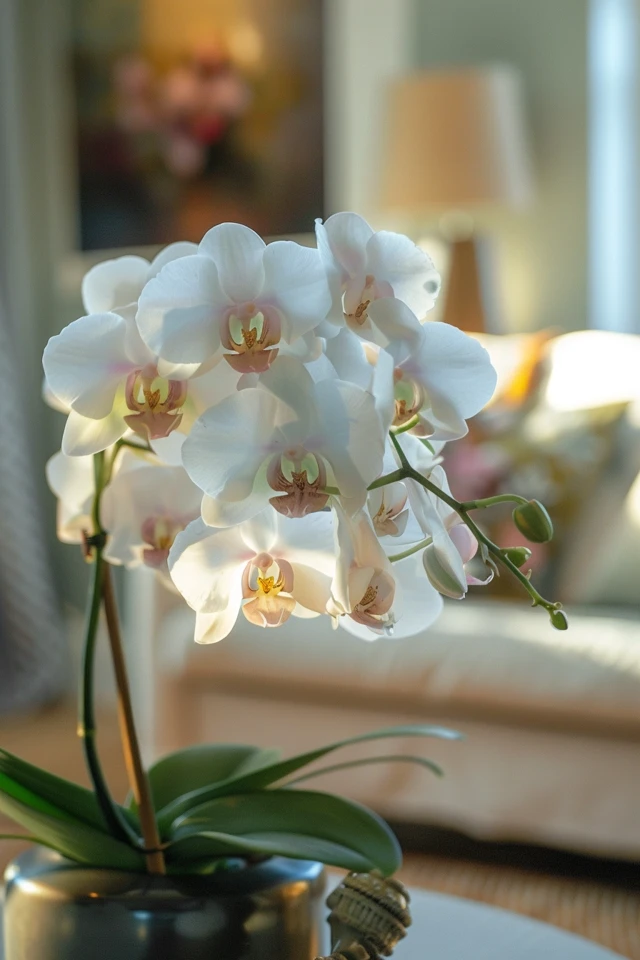Growing orchids in water, also known as water culture or hydroponic orchid growing, is a unique method that can be used to cultivate orchids. This method involves growing orchids without the use of traditional potting media such as bark or coconut husk.
Instead, the orchid roots are submerged in water or rotated between wet and dry conditions. This technique has gained popularity as it helps in preventing common orchid problems like root rot and leaf spots that can occur with traditional potting mixes. It also provides a unique soil-free environment for the orchids to thrive.
To grow orchids in water, you need to un-pot the plant, remove any media from the roots, rinse the roots, and cut away any damaged or rotten material. Then, you can place the orchid in a container with enough room for the roots to grow and add water, preferably using rainwater or distilled water.
It is important to observe the plant for cues on its growth and health and to fertilize the orchid during water changes. There are different variations of water culture, including full water culture, where the roots are partially submerged in water, and semi-water culture, where the roots are alternated between wet and dry conditions.

Key Takeaways:
- Growing orchids in water, also known as water culture or hydroponic orchid growing, is a unique method.
- Orchids grown in water don’t require traditional potting media like bark or coconut husk.
- Water culture helps prevent common orchid problems like root rot and leaf spots.
- Observation and fertilization during water changes are important for orchid care in water culture.
- There are variations of water culture, including full water culture and semi-water culture.
Why Growing Orchids In Water Is A Good Idea
Growing orchids in water offers a range of benefits when compared to traditional pot culture. One of the key advantages is its ability to prevent common orchid issues such as root rot and leaf spots. Unlike traditional potting mixes that can become overly saturated or prone to infection, growing orchids in water allows the roots to experience a wet-dry cycle that closely mimics their natural habitat in the wild.
This method not only ensures that the roots can breathe but also prevents excessive moisture and boggy conditions that can lead to root rot and other fungal diseases. By providing a suitable cultural environment, growing orchids in water mirrors the natural growing conditions of many epiphytic orchids, which derive most of their moisture and nutrients from the air and surrounding water.
Preventing Common Orchid Problems
Growing orchids in water can significantly improve the health of your orchids. It offers a unique and soil-free environment that allows them to thrive without the risk of pathogens or inadequate drainage. With this method, you can provide your orchids with consistent but not excessive moisture, reducing the chances of root issues and leaf spot development.

Mimicking Natural Growing Conditions
Orchids are remarkable plants that have adapted to various growing conditions. By growing orchids in water, you recreate their natural habitat and provide an environment that closely resembles their origin. This enables orchid roots to absorb moisture and nutrients in a manner that is in tune with their evolutionary needs, resulting in healthier and more vibrant plants.
Overall, hydroponic orchid care offers a compelling alternative to traditional pot culture. It not only addresses common orchid problems like root rot and leaf spots but also provides an opportunity to create a unique and beautiful display of orchids thriving in a soil-free environment.
How To Grow Orchids In Water
To grow orchids in water, follow these simple steps. First, un-pot the orchid and remove any potting media or moss from the roots. Rinse the roots well and carefully remove any damaged or rotten material using sterile pruners. Allow the orchid to dry for a day or two to let the pruning cuts heal.
Next, choose a container that provides enough room for the roots to grow and place the orchid in it. It is recommended to use a transparent glass container, allowing you to observe the progress of the plant. To support the roots and prevent rot, add clay pebbles to the bottom of the container.
Finally, add water to the container, preferably using rainwater or distilled water. Avoid using tap water as it may contain chemicals harmful to orchids. The watering schedule can vary; some growers leave their orchids constantly submerged in water, while others alternate between wet and dry conditions. It’s important to closely monitor the plant’s growth and health to determine the optimal watering frequency.
When fertilizing orchids in water culture, use a specialist orchid fertilizer diluted to a quarter of the recommended strength during water changes. If your orchid doesn’t rebloom regularly, fertilizing with kelp once a month can be beneficial. Growing orchids in water requires patience and experimentation to find the best conditions for each individual plant. With proper care and attention, your orchids can thrive in water culture, showcasing stunning exotic flowers and unique roots.


